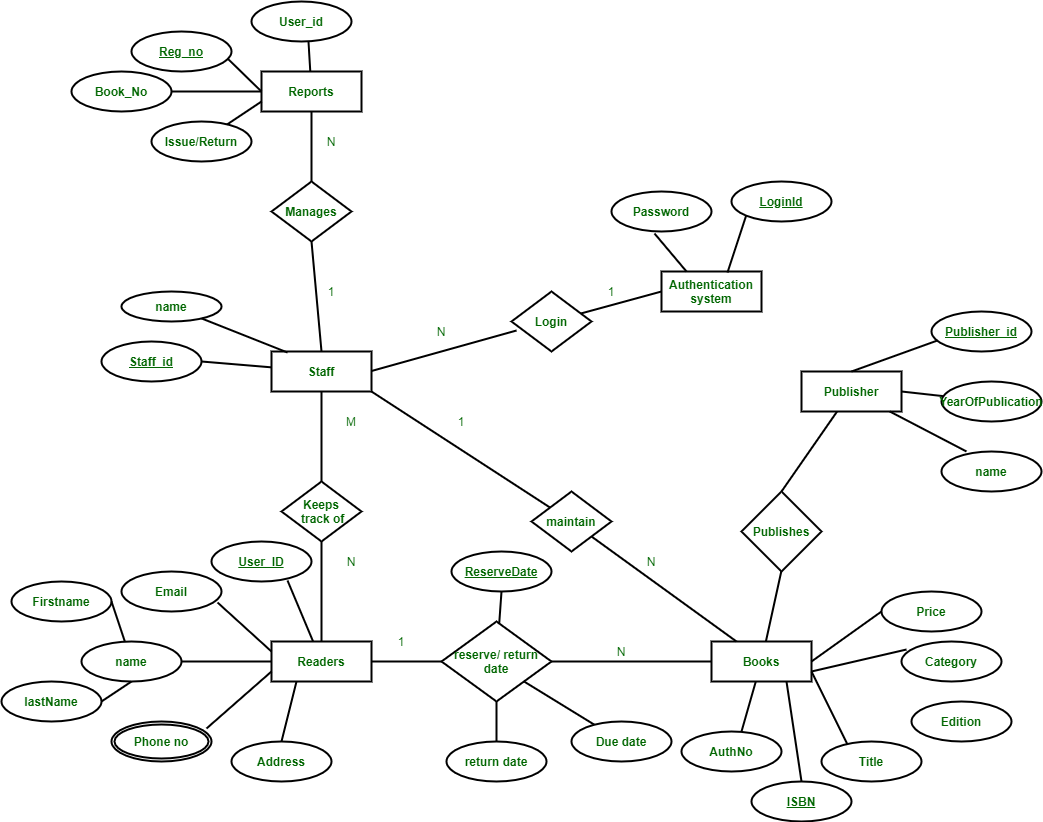ER diagram of Library Management System
Last Updated :
19 Jan, 2024
ER Diagram is known as Entity-Relationship Diagram, it is used to analyze the structure of the Database. It shows relationships between entities and their attributes. An ER Model provides a means of communication.
The Library Management System database keeps track of readers with the following considerations –
- The system keeps track of the staff with a single point authentication system comprising login Id and password.
- Staff maintains the book catalog with its ISBN, Book title, price(in INR), category(novel, general, story), edition, author Number and details.
- A publisher has publisher Id, Year when the book was published, and name of the book.
- Readers are registered with their user_id, email, name (first name, last name), Phone no (multiple entries allowed), communication address. The staff keeps track of readers.
- Readers can return/reserve books that stamps with issue date and return date. If not returned within the prescribed time period, it may have a due date too.
- Staff also generate reports that has readers id, registration no of report, book no and return/issue info.
Note:
Follow given link to build a Web application on Library Management System.
Below is the ER Diagram for Library Management System:

ER Diagram of Library Management System
This Library ER diagram illustrates key information about the Library, including entities such as staff, readers, books, publishers, reports, and authentication system. It allows for understanding the relationships between entities.
Entities and their Attributes –
- Book Entity : It has authno, isbn number, title, edition, category, price. ISBN is the Primary Key for Book Entity.
- Reader Entity : It has UserId, Email, address, phone no, name. Name is composite attribute of firstname and lastname. Phone no is multi valued attribute. UserId is the Primary Key for Readers entity.
- Publisher Entity : It has PublisherId, Year of publication, name. PublisherID is the Primary Key.
- Authentication System Entity : It has LoginId and password with LoginID as Primary Key.
- Reports Entity : It has UserId, Reg_no, Book_no, Issue/Return date. Reg_no is the Primary Key of reports entity.
- Staff Entity : It has name and staff_id with staff_id as Primary Key.
- Reserve/Return Relationship Set : It has three attributes: Reserve date, Due date, Return date.
Relationships between Entities –
- A reader can reserve N books but one book can be reserved by only one reader. The relationship 1:N.
- A publisher can publish many books but a book is published by only one publisher. The relationship 1:N.
- Staff keeps track of readers. The relationship is M:N.
- Staff maintains multiple reports. The relationship 1:N.
- Staff maintains multiple Books. The relationship 1:N.
- Authentication system provides login to multiple staffs. The relation is 1:N.
Like Article
Suggest improvement
Share your thoughts in the comments
Please Login to comment...